Claude Forthomme's Blog, page 37
November 6, 2013
Why the Web is Dangerous: Third Parties Are Watching You

On 4 November, in one hour I visited 10 sites and got watched over by 99 sites, unknown to me! They are the true "Big Brothers watching me". This is the kind of info Lightbeam gives you.
Gary Kovacs' talk on TED almost two years ago was prophetic: "privacy is not an option", he said, and "the memory of the Internet is forever". That was in February 2012, and now that we are living through the scandal of universal NSA surveillance revealed by Moscow-bound Edward Snowden, this is more than ever the case.
In case you missed it, here is Kovacs' talk:
Over 2.4 million viewers! For a TED talk, that's really popular.
He was then the CEO of Firefox, today he is heading AVG, a web security company with 150 million subscribers.
Now what he refers to as "collusion" in the talk has become a Firefox add-on called Lightbeam. All you need to do is log into your Firefox browser and download the add-on. Don't worry, it's not going to blow up your computer. Besides, it's safe and transparent - the whole Lightbeam project is financed by the Ford Foundation and the Natural Sciences and Engineering Research Council (NSERC).
What does Lightbeam do? It enables you to graphically visualize the first and third party sites you interact with when you visit the Web: the round dots on the graph are those you visit, the triangular ones are those who watch you behind your shoulders, and then of course there are more lurking in the deep Web that aren't even identified here...As the Firefox folks say, it helps "illuminate the inner workings of the Web".
Of course, it's a small thing compared to what the NSA can do: as the New York Times summed it up neatly in a recent article (to read it, click here): "Today's NSA is the Amazon of intelligence agencies, as different from the 1950s agency as that online behemoth is from a mom-and-pop bookstore." And small wonder, considering its budget is over $10 billion/year with 35,000 employees! Chances are that they have made the Web less safe as a result of their eavesdropping efforts that weaken encryption systems.
Every little bit helps to stay safe on the Net. Are you using Lightbeam? What do you think of it?
Related articles
 The 'I Am Edward Snowden' Defence(techrights.org)
The 'I Am Edward Snowden' Defence(techrights.org) Former Mozilla CEO Gary Kovacs appointed to head AVG(venturebeat.com)
Former Mozilla CEO Gary Kovacs appointed to head AVG(venturebeat.com) Americans Divided Over Snowden; Republicans Far More Skeptical of Mass Surveillance(cnsnews.com)
Americans Divided Over Snowden; Republicans Far More Skeptical of Mass Surveillance(cnsnews.com)









Published on November 06, 2013 00:19
November 1, 2013
A Painter (My Mother) Celebrates Her 100th Birthday
Are artists particularly prone to longevity? The list of centenarian artists on Wikipedia is long but there's no way you can prove a causal effect beyond the intuition that if you spend your time doing something you love, your life might last longer. For one Grandma Moses who lived to be 101, you always have a Caravaggio who died in his late thirties.
This is by way of introduction: on 20 October, my mother, a professional painter who studied with Delvaux and met with success in the 1960s as a portraitist in New York, celebrated her (first) century on earth. Her art name is "S. Ruyters" where the mysterious S stands for Simone, a name she hates. Her parents had a memorable dispute about what name to give her and her father unilaterally opted for Simone, actually a fashionable name for baby girls at the time - perhaps because of the beautiful Madame Simone, a theater celebrity in pre-World War I Paris who also happened to live to the ripe old age of 108 years (she died in 1985) . Could it be that the name Simone is a guarantee of longevity?
The whole family, including a cute 2 year-old great-granddaughter, met in my mother's home for a celebratory meal last Sunday. Here she is with my husband, both looking very serious over their after-lunch coffee (are they pondering the beauty of the flowers, a gift from my son?):
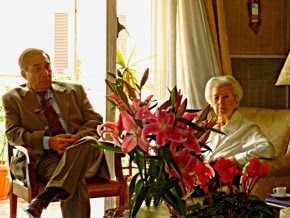
Note that her coffee cup rests on a closed Kindle: my mother is an avid novel reader (one per week) and fond of her e-reader because it is light in her hands and lets her enlarge the letters. She is currently reading Khaled Hosseini's "And the Mountains Echoed" and loving it very much though, she says, she liked "The Kite Runner" better.
The meal was a happy one and marked by a moment of distraction when my mother started to eat her birthday cake straight from the serving dish. When she realized what she was doing, she collapsed laughing - here she is in front of her whipped cream and chestnut "Mont Blanc" brought by my daughter:

Curious about her paintings? She painted every day until five years ago, declaring that her vision was no longer good enough. This is one of her latest paintings (done in 2005), quite humorous, of a monkey puzzled by a fly:

And here's my husband's favorite painting, it was done in the 1960s, when she was experimenting with oil painting done on gold leaves:

And no, this is not anyone's portrait, it's a work of imagination! The 1960s were a particularly prolific time for her, here she is in her studio in New York:
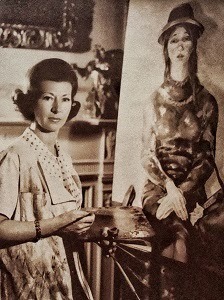
And here is the canvas sitting on her easel:
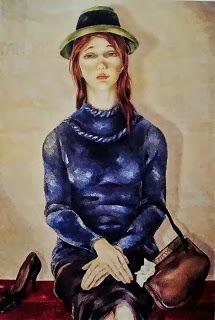
Titled “Melancholy”, this is not a portrait either –
just a girl who’s visited the Metropolitan Museum and her feet are aching! New York was then (as now) a fantastic place to live for artists, and she met many, including Magritte, and here she is with Salvador Dali:

She became famous with her portraits, for example, this one of Barbara Thompson Eisenhower, the former President's daughter-in-law:

She also experimented with tapestries, creating the designs for the French manufacture of Aubusson and the Belgian Brussels tapestries workshop of Chaudoir - like this one that was picked by King Baudouin of Belgium as an official gift for the Soviet government when he visited Russia in 1973:

She even got into interior decoration when she designed furniture like this coffee table with a painted gold leaf top (sold at the time through French Co.):

She held several one man shows and won awards, including the Prix de Monaco in 1965, for "Anxiety":

Here's the painting in question, depicting two sisters after the nuclear holocaust:
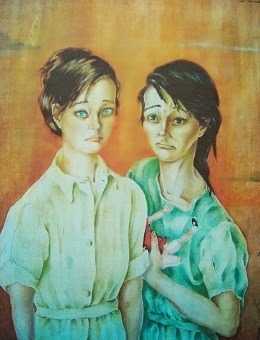
Yes, my mother was a tornado of ideas! She still is...And in the family, we all love her. Happy Birthday, Grand Maman!
To find out more about her and see her paintings, click open the page on S. Ruyters above on top of my blog.
A representative sample of her paintings can also be seen on my Picasa Album: click here










This is by way of introduction: on 20 October, my mother, a professional painter who studied with Delvaux and met with success in the 1960s as a portraitist in New York, celebrated her (first) century on earth. Her art name is "S. Ruyters" where the mysterious S stands for Simone, a name she hates. Her parents had a memorable dispute about what name to give her and her father unilaterally opted for Simone, actually a fashionable name for baby girls at the time - perhaps because of the beautiful Madame Simone, a theater celebrity in pre-World War I Paris who also happened to live to the ripe old age of 108 years (she died in 1985) . Could it be that the name Simone is a guarantee of longevity?
The whole family, including a cute 2 year-old great-granddaughter, met in my mother's home for a celebratory meal last Sunday. Here she is with my husband, both looking very serious over their after-lunch coffee (are they pondering the beauty of the flowers, a gift from my son?):

Note that her coffee cup rests on a closed Kindle: my mother is an avid novel reader (one per week) and fond of her e-reader because it is light in her hands and lets her enlarge the letters. She is currently reading Khaled Hosseini's "And the Mountains Echoed" and loving it very much though, she says, she liked "The Kite Runner" better.
The meal was a happy one and marked by a moment of distraction when my mother started to eat her birthday cake straight from the serving dish. When she realized what she was doing, she collapsed laughing - here she is in front of her whipped cream and chestnut "Mont Blanc" brought by my daughter:

Curious about her paintings? She painted every day until five years ago, declaring that her vision was no longer good enough. This is one of her latest paintings (done in 2005), quite humorous, of a monkey puzzled by a fly:

And here's my husband's favorite painting, it was done in the 1960s, when she was experimenting with oil painting done on gold leaves:

And no, this is not anyone's portrait, it's a work of imagination! The 1960s were a particularly prolific time for her, here she is in her studio in New York:

And here is the canvas sitting on her easel:

Titled “Melancholy”, this is not a portrait either –
just a girl who’s visited the Metropolitan Museum and her feet are aching! New York was then (as now) a fantastic place to live for artists, and she met many, including Magritte, and here she is with Salvador Dali:

She became famous with her portraits, for example, this one of Barbara Thompson Eisenhower, the former President's daughter-in-law:

She also experimented with tapestries, creating the designs for the French manufacture of Aubusson and the Belgian Brussels tapestries workshop of Chaudoir - like this one that was picked by King Baudouin of Belgium as an official gift for the Soviet government when he visited Russia in 1973:

She even got into interior decoration when she designed furniture like this coffee table with a painted gold leaf top (sold at the time through French Co.):

She held several one man shows and won awards, including the Prix de Monaco in 1965, for "Anxiety":

Here's the painting in question, depicting two sisters after the nuclear holocaust:

Yes, my mother was a tornado of ideas! She still is...And in the family, we all love her. Happy Birthday, Grand Maman!
To find out more about her and see her paintings, click open the page on S. Ruyters above on top of my blog.
A representative sample of her paintings can also be seen on my Picasa Album: click here










Published on November 01, 2013 23:35
October 29, 2013
How Nice to be Dead (For and Artist)!

Picasso is still the top earner so far this year, having sold over $233 million in the first three quarters.
The list of the top ten artists, compiled by Artnet (see here), has only ONE artist still alive:
Gerhard Richter, ranked 6th, with $124 million.
It goes to show how nice it is to be dead for an artist...
Keep your fingers crossed! I wish Gerhard Richter many more years of healthy production, I love his work - for example this one:

Gerhard Richeter 19.3.92 Source: Wahooart.com
And here's the trailer of an interesting documentary film done by Corinne Belz (2011) showing how he works:
Incidentally, the high ranking of the two Chinese artists, Zhang Daqian and Qi Baishi who are major 20th century masters, may have to be revised due to the extent of fakes in the Chinese art market (see NYT article below): their paintings have hit record prices in China - like one of Qi Baishi's ink paintings ("An Eagle Standing on a Pine Tree" done in 1946) that sold for a staggering $65.4 million in 2011. But it still has not been paid for, as doubts were raised about its authenticity.
Apparently, the extent of forgery in China is both a cultural phenomenon - the Chinese revere artistic tradition and see no moral problem in "repeating" the masters - and a result of Chinese capitalism, with new billionnaires and speculators adding to the "stir-fry" feel of the market, as the Chinese themselves describe it. I love that expression! The good news is that the Chinese government and the big Chinese auction houses like Poly International and China Guardian, are looking for ways to curb the abuses and restore consumer confidence. The big Western auction houses - Sotheby's and Christie's - have recently been allowed to enter the Chinese market, presumably to provide healthy competition for the more than 350 Chinese auction houses that deal in fine art.
That's yet one more aspect of globalization of the art market at work...
Related article:
 China's Counterfeit Art Boom(nytimes.com)
China's Counterfeit Art Boom(nytimes.com)









Published on October 29, 2013 06:45
October 28, 2013
Google Semantic Search: A Sea Change in SEO or Six Strategies to Increase Your Sales
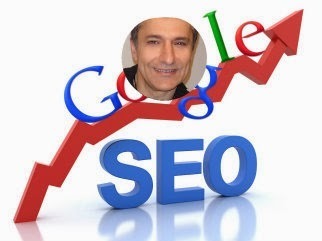
Over the last six months, Google has started to change the rules of the search game and page rankings for websites. It used to be that you could kick your site up in Google rankings and show on top, or near the top, by using Search Engine Optimization (SEO) techniques largely based on the clever peppering of your online posts with key words that were highly popular in searches. In short, with good SEO techniques, you could game the system.
No more.
Google has improved its search algorithms so that what matters now are not simply keywords but content and authority . Their computers can even "see" pictures and recognize the content and they can make connections across the board, so that your online presence and brand will impact what you write and where it turns up in searches.
To understand what's happening, David Amerland's new book, "Google Semantic Search", is a must read. He puts it in a nutshell: your search engine has become an " answer engine ", and that means the amount of trust you can put in the answer you get from Google will determine its value to you. Hence the importance of not just "content" but "authority", i.e. the source of the content.
And here is where your online reputation and networking comes in.
That got me intrigued and I checked the review of an SEO specialist that had some further interesting things to say about the new world of SEOs (see here). And Amerland's book, published in July 2013, is already a best seller on Amazon (#29 for books on SEO).
I checked out the sample (I always do) and found it was written in clear, simple language that is helpful even if
you're not a geek and know nothing about algorithms (my case).
So I bought the book.
My first question was: why is this book focused on Google? Amerland has a convincing answer: For the simple reason, he says, that Google is the dominant player in the global search market: 95% on mobile devices and more than 80% on desk tops. It answers one billion questions every day. If you have anything to sell, from books to peanuts, you can't afford not to be on it.
And here is the crux of the matter, what the sea-change in the SEO industry really means, and you come across it right at the beginning of the book (added highlights are mine):
"In the new SEO world the things that work and help a business take advantage of search and increase its ranking are
Good quality content that delivers value to end-user
Websites that offer an excellent online visitor experience in terms of ease of use, content and navigability
Businesses that are being talked about on the Web, on blogs, and social networks
Businesses whose content is reshared on the Web across social networks
Businesses with a strong social component that actually engages their prospective customer in a way similar to a person
Businesses that stay current and generate consistently fresh content proving that they both have something to say and they are part of the current online conversation." (highlight location 936-62)
No more keywords and tags, just 6 common sense strategies focused on content to increase your online presence and sales, no matter what line of business you're in. Indeed, David Amerland gives you the example of...fresh baked bread!
So the name of the game now is "content marketing", David Amerland is crystal clear: "If you are unable to differentiate yourself sufficiently from your competition, your business will go under...That emotional connection online can only happen with the production of content - great quality content that communicates something important." (highlight location 977-80) Or again: "Clearly this is a new way of doing business. It requires a change from selling a product to a customer to selling an experience to a customer with whom you now have a shared relationship. This is called the relationship economy, and guiding this transition to the relationship economy is the ultimate relationship machine: semantic search."
A "shared relationship" implies in particular that you know who you are talking to on the Web and that you trust that person. It all becomes a question of establishing one's identity and authorship: people must trust that you know what you are talking about! And of course, for the Google search engines, establishing identity and authorship is done on Google+.
Being an economist by training, I find this sort of argument particularly interesting. But I was puzzled: how does this all apply to book selling? Of course, as self-published authors, we are, essentially nothing if not small business entrepreneurs. But how do you apply all this in practice?
I got on Google+ (that's Amerland's advice, right!) and put the question to him. It was great to be able to contact him directly and I started by telling him how useful I thought his book was. Here is his response, extremely illuminating I think, and I thought I'd share it with you here (highlighting is mine):
"I am glad you found it useful. I will try to condense an entire book
I've written on how to use semantic search to promote yourself [as a writer] in as
succinct an answer as possible.
Semantic search is designed to
find the best content and deliver it to the person looking for it at
the best time possible. Amazon may be the best place to sell books but
readers do not buy books without having bought, first, into the writer.
What you're doing with your blog sounds right but execution is critical
here.
Without being able to find your audience (which is where
search comes in) your books will not sell well. There is a community for
writers on Google+ (click here) owned by +Johnny Base - it is invitation only so you will need to ask but the information covered is exactly what you need.
On
the Authorship, I need to clarify, that these are the rules that allow
you to formally claim your writing on the web and be identified as the
author of content you have created in the search results. Here's an
example for 'Google Semantic Search' (http://goo.gl/bsZdU9) it brings up a thumbnail image of me.
There is another Google+ community devoted to the subject (click here) run by +Mark Traphagen who is an authority on this. I would also advise you join this.
Bottom
line semantic search can hugely help writers who suddenly have a
distinct advantage here, because of their writing skills, but there is
no shortcut. You need to find out all the little steps required and
implement them. Good news, none of them is hugely technical. :)"
With my heartfelt thanks to David Amerland, what I take away from this is that is is highly advisable to join the Google+ communities mentioned here and I'd like to add that Johnny Base has also set up a mirror community for writers opened to the public (here) so you might want to start there. And, yes, Amerland's book does clarify "all the little steps required" to take advantage of "semantic search". And I'm glad none of them are "hugely technical" because I'm no techie!


(click here to see it on Amazon)

Related articles
 How the Semantic Web is Changing the Role of the Journalist(semanticweb.com)
How the Semantic Web is Changing the Role of the Journalist(semanticweb.com) 3 ways Google's Hummingbird update will change the nature of search: http://t.co/K5Fn56qKri(socialmediatoday.com)
3 ways Google's Hummingbird update will change the nature of search: http://t.co/K5Fn56qKri(socialmediatoday.com) Google Brings Semantics to Image Search(semanticweb.com)
Google Brings Semantics to Image Search(semanticweb.com)









Published on October 28, 2013 02:34
October 25, 2013
German Bishops' Luxurious Lifestyle Taken to Task by Pope Francis
German bishops drive in BMW, Audi and Mercedes luxury sedans while the Pope does not hesitate to ride around in an old Fiat. Episcopal residences in Germany exude power and luxury. Money is lavishly spent by the Church to maintain them. For example, €2 million on the rococo-style palace of the Munich Archbishopric (the State of Bavaria donated another €6.5 million) and €10 million on a villa in Rome that serves as a guesthouse for the archdiocese.
Meanwhile, the Pope, as we all know, has refused to live in the Papal apartments in the Vatican and has moved permanently to a simple room in the nearby Santa Marta guesthouse and shares his meals with other guests (for more, see Der Spiegel's article here).
The bishop of Limburg has recently shaken Germany when it was revealed that €31 million, six times as much as originally planned, had been spent on his palatial residence facing the cathedral:

Mmm...It goes to show that the Germans are really rich!
The Bishop of Limburg, age 52, a thin and gaunt individual, does not seem to be overly worried by the swirling gossip and discontent. He looks rather happy in the courtyard of his luxurious residence :

For more information, read the Daily Mail's article here.
This is not a new story. Der Spiegel had already drawn attention to the bishop's scandalous profligacy a year ago, in an article, detailing the absurdity of his new residence (at the time as yet unfinished), see here. It even provided an interesting analytical overview of that residence:

What is striking in this picture, if you look closely, is that the Bishop's living quarters (number 6) are about the same size as the area reserved for receptions and conference rooms (number 3), and certainly much larger than any other area, including that destined to the nuns (number 2).
No wonder the Germans are furious and you better not show this to the Greeks...
But wait, the best news came in yesterday. As there is an on-going investigation into the bishop's accounts by the German Bishops' Conference (still on-going), it was expected that at least another two months would pass before the German clerical authorities and Rome took a decision. But lo and behold, the Pope did not wait for the results of the investigation to react. He suspended the Bishop and the accountant who helped him has resigned (see here).
What is interesting is that the Pope did not force the bishop to resign: that would have pre-empted the results of the on-going investigation. But suspending him sent a clear signal about what he wants for the Church.
Humility is in, conspicuous consumption is out!










Meanwhile, the Pope, as we all know, has refused to live in the Papal apartments in the Vatican and has moved permanently to a simple room in the nearby Santa Marta guesthouse and shares his meals with other guests (for more, see Der Spiegel's article here).
The bishop of Limburg has recently shaken Germany when it was revealed that €31 million, six times as much as originally planned, had been spent on his palatial residence facing the cathedral:

Mmm...It goes to show that the Germans are really rich!
The Bishop of Limburg, age 52, a thin and gaunt individual, does not seem to be overly worried by the swirling gossip and discontent. He looks rather happy in the courtyard of his luxurious residence :

For more information, read the Daily Mail's article here.
This is not a new story. Der Spiegel had already drawn attention to the bishop's scandalous profligacy a year ago, in an article, detailing the absurdity of his new residence (at the time as yet unfinished), see here. It even provided an interesting analytical overview of that residence:

What is striking in this picture, if you look closely, is that the Bishop's living quarters (number 6) are about the same size as the area reserved for receptions and conference rooms (number 3), and certainly much larger than any other area, including that destined to the nuns (number 2).
No wonder the Germans are furious and you better not show this to the Greeks...
But wait, the best news came in yesterday. As there is an on-going investigation into the bishop's accounts by the German Bishops' Conference (still on-going), it was expected that at least another two months would pass before the German clerical authorities and Rome took a decision. But lo and behold, the Pope did not wait for the results of the investigation to react. He suspended the Bishop and the accountant who helped him has resigned (see here).
What is interesting is that the Pope did not force the bishop to resign: that would have pre-empted the results of the on-going investigation. But suspending him sent a clear signal about what he wants for the Church.
Humility is in, conspicuous consumption is out!










Published on October 25, 2013 00:27
October 24, 2013
Turkey is At It Again: Leaving the West Behind!

The latest news is that Turkey is buying arms from China, and what is worse, that the Chinese missile systems are not compatible with NATO's.
That means that a pivotal NATO member such as Turkey - I say pivotal because it stands on the edge with the Middle East - is moving away from the military concert of Western democracies...
The Turks may be tired of being called "the sick man of Europe" (see article below) but the patience of Europeans and Americans likewise is running thin, after witnessing Prime Minister Erdogan's shenanigans.
And they are many, rising in a crescendo:
jailing hundreds of dissenting journalists, top generals and officers,
supporting Syrian rebels and, ipso facto, also the most extreme jihadists,
quarreling with Israel over Gaza,
making no attempt to solve the festering Cyprus crisis, the major hurdle to Turkey's entry into Europe,
rebuilding Istanbul in an Ottoman/Muslim revival style causing the ire of local residents,
removing rules governing the attire of public officials in order to enable women civil servants to go to work wearing Muslim-style head scarves.
And this is only a summary list of the most egregious offenses.
Erdogan is busy killing off the pro-western democracy built by Ataturk, the founding father of modern Turkey. Small wonder liberal Turks take to the streets and protest!
Quo vadis, Turkey? Where will you end up?
Related articles
 Erdogan's top adviser says Europe's end closer(worldbulletin.net)
Erdogan's top adviser says Europe's end closer(worldbulletin.net) NATO expresses concern about Turkey's Chinese missile deal(en.trend.az)
NATO expresses concern about Turkey's Chinese missile deal(en.trend.az) Let's stop deluding ourselves about Turkey, says Liberman(timesofisrael.com)
Let's stop deluding ourselves about Turkey, says Liberman(timesofisrael.com) How Turkey betrayed Israel and the U.S.(miamiherald.com)
How Turkey betrayed Israel and the U.S.(miamiherald.com) Report: U.S. Cancelled Drone Delivery to Turkey(israelnationalnews.com)
Report: U.S. Cancelled Drone Delivery to Turkey(israelnationalnews.com) Turkey-China missile deal angers U.S.(worldbulletin.net)
Turkey-China missile deal angers U.S.(worldbulletin.net) Turkish PM reminds NATO members have Russian weaponry(worldbulletin.net)
Turkish PM reminds NATO members have Russian weaponry(worldbulletin.net) Turkish Jews Begin to Leave(commentarymagazine.com)
Turkish Jews Begin to Leave(commentarymagazine.com)Related articles










Published on October 24, 2013 01:07
October 22, 2013
"Tristeza" or Sadness: A Weird Disease that Destroys Sicilian Blood Oranges

With globalization, strange diseases have invaded the world, including one oddly called "Tristeza" or "Sadness". It attacks blood oranges with devastating effects: The plants droop with melancholy and produce tiny oranges the size of ping pong balls instead of the big, bright red ones that have made Sicilian blood oranges famous.
If you've never heard of blood oranges, you can catch up on them here: they're full of extra vitamins and antioxidants, no doubt the result of the volcanic vapors of Mount Etna (just kidding!). Scientists are even working on genetically improving blood oranges to combat obesity and heart disease, see here and here (I am not kidding).
And now, all this goodness is threatened by a form of citrus greening disease. There's nothing that can be done to save the trees except pull them up, burn them and replace them with new, disease-resistant varieties
of blood oranges. The only problem: it will take six years before full
production is resumed.

The disease came from the East many years ago and now it has invaded the whole world, California included. In Sicily, the alarm was finally sounded early this year. Contrary to what has happened in California where, as far back as 1963, an institution has been set up to address the issue, the Central California Tristeza Eradication Agency, nothing has yet been done in Sicily... except for issuing edicts, the latest one in July (see here) ordering that diseased plants should be pulled up. Growers are left to fend for themselves and compete with each other to locate new disease-free cultivars...
Yet this latest edict is a step forward: instead of calling for full eradication of a plantation, hitting healthy and diseased plants alike (as an earlier edict had done), it distinguishes between "ceppo severo" (strong form) and "ceppo blando" (weak form) of the virus.
But is that a scientifically serious approach since there is no cure?
In the meantime, funds are soon to become available from the regional government to assist growers and compensate them for their losses (see here): they will get between €46 and 71 for every plant they've had to pull up, peanuts but perhaps better than nothing.
A typically Italian story...The truth is, the situation isn't all that bad, the production of blood oranges may drop a little but won't disappear, and growers won't go bankrupt.
This is still the country of sunshine, songs and smiles...and blood oranges!
Related articles
 10 things to know before visiting Sicily(edition.cnn.com)
10 things to know before visiting Sicily(edition.cnn.com) The Changing Face of the Mafia(topdocumentaryfilms.com)
The Changing Face of the Mafia(topdocumentaryfilms.com) DIY Beauty Kitchen: Blood Orange(everythinggirlslove.com)
DIY Beauty Kitchen: Blood Orange(everythinggirlslove.com) The Blood Orange Superstar(ireport.cnn.com)
The Blood Orange Superstar(ireport.cnn.com)









Published on October 22, 2013 23:13
Mitoraj: A Major Yet Misunderstood Contemporary Artist

Igor Mitaroj, a polish sculptor, is one of the best contemporary artists alive today, yet he is totally anti-conformist and counter-current, unique in both his style and ethical search.
For many modern art critics, he is difficult to understand, they don't know what to make of him. Why? Because unlike all the other major contemporary artists, his starting point is Beauty - classical beauty, like in Ancient Greece. Contrast this with Marcel Duchamp, the grandaddy of Conceptual Art, whose starting point was a urinal that he signed "R.Mutt" and put upside down:

Marcel Duchamp's original fountain (1917; see Wikipedia) Several more copies were made to be shown in major museums around the world
The idea of starting with ugliness, gore and dirt was such a success that as late as the 1960s, his follower Piero Manzoni hit fame with a very simple idea: his "artist's shit" placed in a box that he priced at the current cost of gold...
Mitoraj will have none of this. The key to understand his art is to see how he plays with Beauty and does this using the element of Time. The passage of Time, as we all know, destroys Beauty, today there is little left of the splendor of the ancients. He is so enthralled with Time that he takes it in his hands and applies it to Beauty. He deliberately destroys his artwork in a way that makes you viscerally feel how Time and Beauty interact to create more beauty .
Time and Beauty: those are the two keys to Mitoraj's art. Beauty is the prisoner of mortality...
See how the statue you see above, that he says he made as a greeting for Rome, blends poignantly into the cityscape:

Recently, he gave an interview on ARTE TV and explained how he loves Greece, he sees it as the cradle of our civilization. And, he added frowning, that he was scandalized by what the Germans and Ms. Merkel did to Greece with their austerity policies. I couldn't agree more.
Here is an artist I love and whose political views are also mine!
(Source of Mitoraj photos: http://medea.provincia.venezia.it/est/amelia/mitoraj/mitoraj.htm)
Related articles
 Exhibition: 'Piero Manzoni. When Bodies Became Art' at Städel Museum, Frankfurt(artblart.com)
Exhibition: 'Piero Manzoni. When Bodies Became Art' at Städel Museum, Frankfurt(artblart.com) Nude on Staircase, Wild Matisse Shocked at Armory Show - Bloomberg(bloomberg.com)
Nude on Staircase, Wild Matisse Shocked at Armory Show - Bloomberg(bloomberg.com) Duchamp and the Dadaist Gender Offensive(artlark.org)
Duchamp and the Dadaist Gender Offensive(artlark.org)









Published on October 22, 2013 01:24
October 21, 2013
Should You Read "The Luminaries", the Winner of the Man Booker Prize? A Quick Review

Surprise, the Man Booker Prize, Britain's most prestigious literary prize, has just been awarded to a New Zealand author, 28 years old, the youngest winner ever. "The Luminaries" is also the longest book ever, 832 pages, much bigger than any of the other shortlisted books (see picture above).
This is Eleanor Catton's second novel, she took three years to write it. She has bewitched the writing community, will she now also bewitch readers?
The media is raving about this book hailed by the Booker Prize judges for "conjuring a world of greed and gold" (see articles below) - indeed, it is set in the last years of the New Zealand gold rush, in the 1860s. Bill Rohrbach who's reviewed it for The New York Times has come out with a lengthy laudatory piece (see here), saying in substance that in spite of the length, by the end, lo and behold, there is a "sliver that delivers". Indeed, he thought it was a lot of fun to read, like doing a "Charlotte Brontë-themed crossword puzzle while playing chess and Dance Dance Revolution on a Bongo Board." He has no doubts: "'The Luminaries' is a true achievement. Catton has built a lively parody
of a 19th-century novel, and in so doing created a novel for the 21st,
something utterly new."
Creating a 21st century novel using 19th century language? Hum...Yet, in spite of the exaggerations, it sounds like something one shouldn't miss. On Amazon, one customer nicely summed up the problem with this book: "Gushing
reviews are easy to write (so are pans), but what to say when you know
that a book is well written, innovatively and creatively structured, and is destined to be loved by many, but it just didn't appeal to you? 'The Luminaries' is such a book." (review from Mary Lins, member of Amazon's Vine Voice program that provides reviewers with advance copies - she gave it 3 stars out of 5 and her review is considered "most useful" by Amazon). Another one (who gave it a one star) wrote "This is everything a book shouldn't be. Cold. Contrived. Tedious. Dishonest." Okay, it sure is easy to pan a book...
Once again, like in the case of Egger's book "The Circle" (quick review here), I was curious and downloaded on my Kindle a sample of the book. The digital edition costs some $16 on Amazon (more if you live in Europe because of the "whispernet" charge and/or tax) - the digital version costs $2 more than the hardcover, a bizarre marketing strategy, yet one that traditional publishers appear to favor, no doubt to try and "protect" their printed edition. It has garnered 31 customer reviews since its release on October 15. On Goodreads, true to form (this is a site that is characterized by an avalanche of ratings), it has already received 264 ratings for an average of 3.90 stars (out of 5) and 96 reviews .
Length of sample: about 45 pages. It is to be noted however that the text starts only after several pages (8% of sample) dedicated to stuff like table of contents, dedication and an enigmatic note to the reader that doesn't clarify anything - in fact, it is rather irritating and pointless. So for such a big book, you don't get that much of a sample, though as usual, you can "look inside" on Amazon, including the end.
Sample Analysis: The book, divided in 12 parts like the Zodiac, features the intertwined stories of 13 men seeking their fortune, including Walter Moody, a just-arrived Scottish immigrant.
The book opens with a scene in the Crown Hotel in Hokitika, a town near the gold fields, in a smoking room on a dark and stormy night where all 13 men are gathered. You are immediately introduced to Walter Moody who has just walked in, feeling "queasy and disturbed" by the presence of the others. He is described in true 19th century style:
"Moody's natural expression was one of readiness and attention. His grey eyes were large and unblinking, and his supple, boyish mouth was usually poised in an expression of polite concern. His hair inclined to a tight curl;it had fallen in ringlets to this shoulders in his youth, but now he wore it close against his skull, parted on the side and combed flat with a sweet-smelling pomade that darkened its golden hue to an oily brown. His brow and cheeks were square, his nose straight, and his complexion smooth. He was not quite eight-and-twenty, still swift and exact in his motions, and possessed the kind of roguish, unsullied vigour that conveys neither gullibility nor guile. He presented himself in the manner of a discreet and quick-minded butler, and as a consequence was often drawn into the confidence of the least voluble of men, or invited to broker relations between people he had only lately met. He had, in short, an appearance that betrayed very little about his own character, and an appearance that others were immediately inclined to trust. Moody was unaware of the advantage his inscrutable grace afforded him. Like most excessively beautiful persons, he had studied his own reflection minutely and, in a way, knew himself from the outside best; he was always in some chamber of his mind perceiving himself from the exterior."
Wow, if his "vigour" conveys "neither gullibility nor guile", what does it convey then? No matter, I'm nitpicking. This is a pretty exhaustive description and written in a leisurely, convoluted style that recalls Dickens or Balzac. Also, the point of view is notably omniscient: you are outside Walter Moody's mind, you are looking at him but you are also told what he is thinking - it is the sort of point of view that triggers the feeling of being thrown into the 19th century.
As you might expect, not much happens in this first chapter, people talk, a mysterious murder is hinted at, unsavory characters that appear to be disliked by the group are mentioned, a complex past is partly evoked by Walter Moody who is indeed, as his name suggests, a moody, multi-layered character, unwilling to unbutton himself to the group in the room. And small wonder, these men are a strange and diverse lot. Mostly white, they include inexplicably a Maori tattooed native and two Chinese men.
So what are the hooks that might induce you to buy it?
Hook #1: The writing style. As the description of Walter Moody quoted above suggests, this is a style that can either draw you in or irritate you because of the minutiae it closely examines, like a literary microscope. It is obvious that the pace is going to be very, very slow and depending on your temper, you might savor it or hate it.
Dialogues are wordy, interspersed with long flashbacks. At a certain point, the logistics of the scene beg disbelief: the man Walter Moody is talking to offers to go and bring him back a drink - the bar is just a few steps away - and yet he doesn't return for quite a while, enough time for every man in the group to whisper to each other and for a new person to start a conversation with Walter. Why doesn't the original interlocutor return with the promised drink? The whole scene is contrived, the pacing is off and that is a pity because you stop believing in what the author intends to tell you.
The writing does however succeed very well in evoking a time and a turn of mind. But Eleanor Catton is not the only one capable of this. Notably Peter Ackroyd has managed to successfully evoke 19th century settings, most recently in his peculiar "The Casebook of Victor Frankenstein" (published in 2008, I blogged about it here).
Hook # 2: The Main Character, Walter Moody has a family past that haunts him. Using most of his inheritance, he has saved his father's second wife from poverty when she was abandoned by his father who'd escaped to New Zealand, along with his elder brother. Walter comes out looking like a knight in white armor while his father and his brother both sound like despicable and dangerous villains, particularly the father who, after hitting gold, has remarried and is guilty of bigamy. Not unsurprisingly, Walter Moody is ashamed of his family. But you are left to wonder what will happen next, as the father and brother (who live in another part of New Zealand) are not likely to leave Walter alone.
Hook # 3: A mystery murder in an unusual setting. In spite of the slow pace of the story telling, you realize that Walter Moody witnessed something dreadful on the ship bringing him to Hokitika. What it is, you are not given to know. The setting is also a refreshing change from the California gold rush.
Conclusion: Hooks # 2 and # 3 work well, the only problem is with the writing style. I can see why some feel it is pretentious. Could I live with it for 832 pages? I am not sure. I think I'll wait and buy it when the price drops down...
If you've read it, please share your opinion with us. If you're interested in reading it, you can find it on Amazon, click the icon:
Related articles
 Man Booker Prize Goes to The Luminaries Author Eleanor Catton(guardianlv.com)
Man Booker Prize Goes to The Luminaries Author Eleanor Catton(guardianlv.com) Man Booker Prize 2013: Eleanor Catton's The Luminaries is gripping and virtuosic(telegraph.co.uk)
Man Booker Prize 2013: Eleanor Catton's The Luminaries is gripping and virtuosic(telegraph.co.uk) Gold rush brings heavy rewards for Eleanor Catton, youngest Man Booker Prize winner(thetimes.co.uk)
Gold rush brings heavy rewards for Eleanor Catton, youngest Man Booker Prize winner(thetimes.co.uk) Booker Prize: Catton Becomes Youngest Winner(news.sky.com)
Booker Prize: Catton Becomes Youngest Winner(news.sky.com) At 28, Writer Is Youngest to Receive Booker Prize(thelittlereadersclub.wordpress.com)
At 28, Writer Is Youngest to Receive Booker Prize(thelittlereadersclub.wordpress.com) Smart Money Is On Eleanor Catton For The Man Booker Prize 2013(contactmusic.com)
Smart Money Is On Eleanor Catton For The Man Booker Prize 2013(contactmusic.com) Booker prize: Eleanor Catton becomes youngest winner for The Luminaries(theguardian.com)
Booker prize: Eleanor Catton becomes youngest winner for The Luminaries(theguardian.com)









Published on October 21, 2013 00:41
October 18, 2013
Why Imany's Debut Song, "You Will Never Know", is a Hit

Imany, born in France but originating from the Comoros Islands, daughter of a military man, was first a hit model in New York before becoming a hit singer. The signature song of her debut album is "You Will Never Know", it first came out in 2011, here:
And now that her album, called "The Shape of a Broken Heart", is out, the song was re-released in a new "official" video clip that however I cannot see because the producer didn't buy the rights for my country of residence (Italy), see here:
Now, I'm sorry but if you're Italian, you can't see this video. If not, then all I can say is: enjoy! And tell me if there's a difference with the original video...
What strikes me about this song is the obvious play on "know" and "no", she's good at pulling off the echoing sounds of the two words and uses her harsh, sexy voice to great effect. As the Japan Times says, she keeps it simple with her guitar, indeed, that's what she wants to ensure that her music is "timeless" (see article below). Could that be the very reason for her success? I believe it is, well done, Imany!
Incidentally, her breakthrough didn't come easily, she turned to singing in 2008. It takes courage and perseverance to operate such a u-turn, away from modeling and into an entirely new career as demanding as that of an artist/singer. She composes her own songs and does it directly in English, not her mother tongue, and that too, in itself, is remarkable.
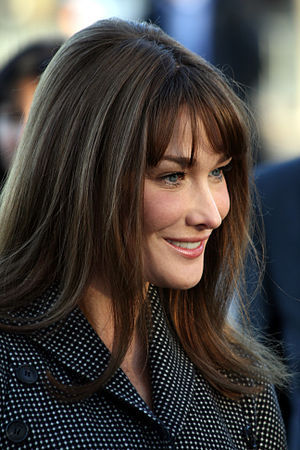
Carla at 2008 Armistice Day
Of course, she's not the only French singer who's done that. Carla Bruni is a famous path breaker, just out now with her latest album after her stint as wife of a French President (it was Sarkozy, remember?)
What is your opinion, how do you like Imany? You can also "like" her on her Facebook page, here. You'll see she's inching towards 200,000 "likes", for a new artist, just 27 years old, that's cool...
Related articles
 Imany makes peace with her voice on debut album(japantimes.co.jp)
Imany makes peace with her voice on debut album(japantimes.co.jp) Imany(bookiemodastyle.com)
Imany(bookiemodastyle.com)









Published on October 18, 2013 00:58



